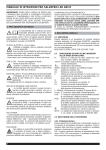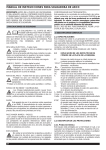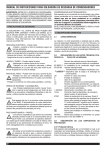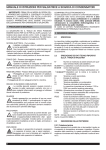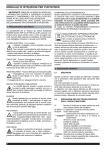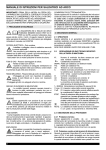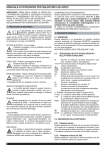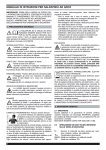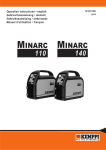Download Cebora Power Tig 1540 DC-HF Instruction manual
Transcript
INSTRUCTION MANUAL FOR ARC WELDING MACHINE IMPORTANT: BEFORE STARTING THE EQUIPMENT, READ THE CONTENTS OF THIS MANUAL, WHICH MUST BE STORED IN A PLACE FAMILIAR TO ALL USERS FOR THE ENTIRE OPERATIVE LIFE-SPAN OF THE MACHINE. THIS EQUIPMENT MUST BE USED SOLELY FOR WELDING OPERATIONS. 1 SAFETY PRECAUTIONS WELDING AND ARC CUTTING CAN BE HARMFUL TO YOURSELF AND OTHERS. The user must therefore be educated against the hazards, summarized below, deriving from welding operations. For more detailed information, order the manual code 3.300.758 ELECTRIC SHOCK - May be fatal. · Install and earth the welding machine according to the applicable regulations. · Do not touch live electrical parts or electrodes with bare skin, gloves or wet clothing. · Isolate yourselves from both the earth and the workpiece. · Make sure your working position is safe. FUMES AND GASES - May be hazardous to your health. · Keep your head away from fumes. · Work in the presence of adequate ventilation, and use ventilators around the arc to prevent gases from forming in the work area. ARC RAYS - May injure the eyes and burn the skin. · Protect your eyes with welding masks fitted with filtered lenses, and protect your body with appropriate safety garments. · Protect others by installing adequate shields or curtains. RISK OF FIRE AND BURNS · Sparks (sprays) may cause fires and burn the skin; you should therefore make sure there are no flammable materials in the area, and wear appropriate protective garments. NOISE This machine does not directly produce noise exceeding 80dB. The plasma cutting/welding procedure may produce noise levels beyond said limit; users must therefore implement all precautions required by law. PACEMAKERS · The magnetic fields created by high currents may affect the operation of pacemakers. Wearers of vital electronic equipment (pacemakers) should consult their physician before beginning any arc welding, cutting, gouging or spot welding operations. EXPLOSIONS · Do not weld in the vicinity of containers under pressure, or in the presence of explosive dust, gases or fumes. · All cylinders and pressure regulators used in welding operations should be handled with care. ELECTROMAGNETIC COMPATIBILITY This machine is manufactured in compliance with the instructions contained in the harmonized standard EN50199, and must be used solely for professional purposes in an industrial environment. There may be potential difficulties in ensuring electromagnetic compatibility in non-industrial environments. IN CASE OF MALFUNCTIONS, REQUEST ASSISTANCE FROM QUALIFIED PERSONNEL. 2 GENERAL DESCRIPTIONS 2.1 SPECIFICATIONS This welding machine is a constant current power source built using INVERTER technology, designed to weld covered electrodes (not including cellulosic) and for TIG procedures, with contact starting and high frequency. IT MUST NOT BE USED TO DEFROST PIPES. 2.2 EXPLANATION OF THE TECHNICAL SPECIFICATIONS LISTED ON THE MACHINE PLATE. N°. Serial number, which must be indicated on any type of request regarding the welding machine. Single-phase static transformer-rectifier frequency converter. Drooping-characteristic. SMAW Suitable for welding with covered electrodes. TIG Suitable for TIG welding. U0. Secondary open-circuit voltage X. Duty cycle percentage. % of 10 minutes during which the welding machine may run at a certain current without overheating. I2. Welding current U2. Secondary voltage with current I2 U1. Rated supply voltage The machine has an automatic supply voltage selector. 1~ 50/60Hz 50- or 60-Hz single-phase power supply I1 max. This is the maximum value of the absorbed current. I1 eff. This is the maximum value of the actual current absorbed, considering the duty cycle. IP23C Protection grade of the housing, approving the equipment as suitable for use outdoors in the rain. C: The additional letter C means that the equipment is protected against access to the live parts of the power circuit by a tool (diameter 2.5 mm ). S Suitable for hazardous environments. NOTES: The welding machine has also been designed for use in environments with a pollution rating of 3. (See IEC 664). 2.3 DESCRIPTION OF PROTECTIVE DEVICES 2.3.1. Thermal protection This machine is protected by a thermostat, which prevents the machine from operating if the allowable temperatures are exceeded. Under these conditions the fan keeps running and the LED G lights. NOTE: If upon starting the supply voltage is below 170V, the LEDs light, the fan is powered but the machine does not deliver current 5 2.3.2 Motor-driven generators These must have a power equal to or greater than 6KVA, and must not deliver a voltage greater than 260V. 3 INSTALLATION MMA F - LED. MMA welding This machine can weld all types of covered electrodes* except for cellulosic. The welding current is adjusted using the knob H. TIG Make sure that the supply voltage matches the voltage indicated on the specifications plate of the welding machine. When mounting a plug, make sure it has an adequate capacity, and that the yellow/green conductor of the power supply cable is connected to the earth pin. The capacity of the overload cutout switch or fuses installed in series with the power supply must be equivalent to the absorbed current I1 of the machine. WARNING! Extension cords of up to 30m must have a cross-section of at least 2.5 mm2. 3.1 START-UP E - LED. 2-stage TIG welding (manual). Start without high frequency. To light the arc, press the torch trigger and touch the tungsten electrode to the workpiece, then lift it. This move must be quick and decisive. After starting, the current reaches the value set using knob H.When the trigger is released, the current begins to drop over the "slope down" time previously set using knob M, until it returns to zero. In this position, you may connect the pedal control accessory ART. 193, TIG Only skilled personnel should install the machine. All connections must be carried out according to current regulations, and in full observance of safety laws (regulation CEI 26-10 - CENELEC HD 427). 3.2 DESCRIPTION OF THE EQUIPMENT D - LED. 4-stage TIG welding (automatic). Start without high frequency. This program differs from the previous one in that the arc is both started and shut off by pressing and releasing the torch trigger TIG C - LED. 2-stage TIG welding (manual). Start with high frequency. To light the arc, press the torch trigger: a high voltage/frequency pilot spark will light the arc. The operating logic is the same as described for the LED E. In this position, you may connect the pedal control accessory ART. 193, TIG H G F E D C B A M L 95 75 50 MMA 70 90 50 115 I 115 TIG 130 135 25 25 MMA 5 3 2 0 4 5 6 7 A TIG 10 8 9 10 G - LED - THERMAL PROTECTION Lights when the operator exceeds the duty cycle or percentage intermittence admissible for the machine, and simultaneously blocks the current output. NOTE: In this condition the fan continues cooling the power source. 140 150 10 TIG B - LED. 4- stage TIG welding (automatic). Start with high frequency. This program differs from the previous one in that the arc is both started and shut off by pressing and releasing the torch trigger 5 1 15 20 25 30 POWER TIG 1540 DC HF ® 95 75 50 70 50 115 10 P Q 4 10 5 1 A - Procedure and mode selector switch This push-button selects the welding procedure (MMA or TIG) and mode. The selection changes each time the button is pressed. The LEDs light alongside the various symbols to display your choice. 6 MMA 5 3 2 0 115 H - KNOB Adjusts the welding current. 130 135 25 25 O 90 5 15 6 140 TIG 150 A M - KNOB 7 8 Slope down. This is the time in which the current 9 10 reaches the minimum value and the arc shuts off. (0-10 sec.) 20 25 30 L - KNOB Post gas. Adjusts the time gas flows after welding ends. (0-30 sec.) I - 10-PIN CONNECTOR The following remote controls are connected to this connector: a) foot control b) torch with start button c) torch with up/down, etc… O - 1/4 GAS FITTING This is where the gas hose of the TIG welding torch is to be connected. 1~ MMA f1 f2 POWER TIG 1540 DC HF TIG Art.271 0 IP 23C IEC 60974-1 EN 50199 S I V Nº ® S Via A.Costa, 24 40057-Cadriano-Bologna-Italy MADE IN ITALY size and length of the welding cables are compatible with the current used. 3.4 - This welding machine is suitable for welding all types of electrodes, with the exception of cellulosic (AWS 6010)*. - Make sure that the switch S is in position 0, then connect the welding cables, observing the polarity required by the manufacturer of the electrodes you will be using; also connect the clamp of the ground cable to the workpiece, as close to the weld as possible, making sure that there is good electrical contact. - Do NOT touch the torch or electrode clamp simultaneously with the earth clamp. - Turn the machine on using the switch S. - Select the MMA procedure by pressing the button A: LED F lit. - Adjust the current based on the diameter of the electrode, the welding position and the type of joint to be made. - Always remember to shut off the machine and remove the electrode from the clamp after welding. 3.5 R P - Negative output terminal (-) Q -Positive output terminal (+) MMA WELDING (MANUAL METAL ARC) TIG WELDING This welding machine is suitable for welding stainless steel, iron, or copper using the TIG procedure. Connect the earth cable connector to the positive pole (+) of the welding machine, and the clamp to the workpiece as close as possible to the welding point, making sure there is good electrical contact. Connect the power connector of the TIG torch to the negative pole (-) of the welding machine. Connect the torch connector to the welding machine connector I. Connect the torch gas hose fitting to the fitting O on the machine, and the gas hose from the cylinder pressure regulator to the gas fitting R on the rear panel. Turn on the machine. Do not touch live parts and output terminals while the machine is powered. The first time the machine is switched on, select the mode using the button A and the welding current using the knob H. The flow of inert gas must be set to a value (in liters per minute) approximately 6 times the diameter of the electrode. 4 REMOTE CONTROLS 0 S - switch Turns the machine on and off I R - gas intake fitting 3.3. GENERAL NOTES Before using this welding machine, carefully read the standards CEI 26/9 - CENELEC HD 407 and CEI 26.11 - CENELEC HD 433. Also make sure the insulation of the cables, electrode clamps, sockets and plugs are intact, and that the The following remote controls may be connected to adjust the welding current for this welding machine: Art. 193 Foot control (used in TIG welding) Art (1266) TIG UP/DOWN Torch. Art 1192+Art 187 (used in MMA welding) ART. 1180 Connection to simultaneously connect the torch and the pedal control. ART. 193 may be used in any TIG welding mode with this accessory. Remote controls that include a potentiometer regulate the welding current from the minimum to the maximum current set via the knob H. Remote controls with UP/DOWN logic regulate the welding current from the minimum to the maximum. 7



